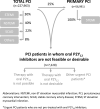Analysis of the Financial Impact of Using Cangrelor on the Safety and Efficacy Outcomes in Patients Undergoing Percutaneous Coronary Intervention in Whom Oral Therapy with P2Y12 Inhibitors is Not Feasible or Desirable, in Spain
- PMID: 33536769
- PMCID: PMC7850430
- DOI: 10.2147/CEOR.S290377
Analysis of the Financial Impact of Using Cangrelor on the Safety and Efficacy Outcomes in Patients Undergoing Percutaneous Coronary Intervention in Whom Oral Therapy with P2Y12 Inhibitors is Not Feasible or Desirable, in Spain
Abstract
Purpose: Cangrelor is an intravenous, direct-acting, reversible P2Y12 inhibitor indicated for the reduction of thrombotic cardiovascular events in patients with coronary artery disease (CAD) undergoing percutaneous coronary intervention (PCI) in whom oral P2Y12 inhibitors are not feasible or desirable. The objective was to assess the financial impact of introducing cangrelor into the hospital formulary in Spain.
Patients and methods: A budget impact model was developed to calculate the cost difference between two scenarios (without and with cangrelor) to treat CAD patients undergoing PCI in whom oral P2Y12 inhibitors are not feasible or desirable, over 3 years. Intravenous P2Y12 inhibitor (cangrelor), oral P2Y12 inhibitors (clopidogrel, prasugrel, and ticagrelor), and glycoprotein IIb-IIIa inhibitors (GPIs) for bail-out use were considered. Epidemiological, efficacy (thrombotic events including cardiac death), safety (bleeding events), and costs (€, 2019) data were based on Spanish registries, clinical trials, and meta-analyses. One-way sensitivity analysis established the effect of uncertainty on results.
Results: For years 1, 2, and 3, the target population to receive cangrelor was 607, 1,822, and 3,340 patients, and cangrelor uptake was 23.70%, 58.30%, and 51.30%, respectively. The 3-year budget impact was 1,021,717€ varying from 50,245€ in year 1 to 599,272€ in year 3. The results were sensitive to the number of patients treated with GPIs in Spanish hospitals.
Conclusion: Based on our results, the financial effort needed to introduce the use of cangrelor in patients undergoing PCI in whom antiplatelet therapy with oral P2Y12 inhibitors is not feasible or desirable barely exceeds one million € over three years, in Spain.
Keywords: P2Y12 inhibitors; budget impact; cangrelor; percutaneous coronary intervention.
© 2021 Lizano-Díez and Paz Ruiz.
Conflict of interest statement
ILD is an employee at Ferrer. SPR reports personal fees from Ferrer, during the conduct of the study. The authors report no other conflicts of interest in this work.
Figures



Similar articles
-
The Budget Impact of Cangrelor in the UK for the Treatment of Out-of-Hospital Cardiac Arrest Patients Who Require Percutaneous Coronary Intervention.Clinicoecon Outcomes Res. 2025 Mar 15;17:189-197. doi: 10.2147/CEOR.S475503. eCollection 2025. Clinicoecon Outcomes Res. 2025. PMID: 40115873 Free PMC article.
-
Cangrelor With and Without Glycoprotein IIb/IIIa Inhibitors in Patients Undergoing Percutaneous Coronary Intervention.J Am Coll Cardiol. 2017 Jan 17;69(2):176-185. doi: 10.1016/j.jacc.2016.10.055. J Am Coll Cardiol. 2017. PMID: 28081827 Clinical Trial.
-
Safety of cangrelor and transition to oral P2Y12 inhibitors in patients undergoing percutaneous coronary intervention: the ARCANGELO study.Eur Heart J Open. 2023 Aug 28;3(4):oead076. doi: 10.1093/ehjopen/oead076. eCollection 2023 Jul. Eur Heart J Open. 2023. PMID: 37646045 Free PMC article.
-
Current status of data on cangrelor.Pharmacol Ther. 2016 Mar;159:102-9. doi: 10.1016/j.pharmthera.2016.01.004. Epub 2016 Jan 21. Pharmacol Ther. 2016. PMID: 26802900 Review.
-
Impact of new oral or intravenous P2Y12 inhibitors and clopidogrel on major ischemic and bleeding events in patients with coronary artery disease: a meta-analysis of randomized trials.Atherosclerosis. 2014 Apr;233(2):568-578. doi: 10.1016/j.atherosclerosis.2014.01.017. Epub 2014 Jan 21. Atherosclerosis. 2014. PMID: 24534451 Review.
Cited by
-
The Budget Impact of Cangrelor in the UK for the Treatment of Out-of-Hospital Cardiac Arrest Patients Who Require Percutaneous Coronary Intervention.Clinicoecon Outcomes Res. 2025 Mar 15;17:189-197. doi: 10.2147/CEOR.S475503. eCollection 2025. Clinicoecon Outcomes Res. 2025. PMID: 40115873 Free PMC article.
References
-
- Cid Alvarez AB, Rodriguez Leor O, Moreno R, Peez de Prado A. Registro Español de Hemodinámica y Cardiología Intervencionista. XXVIII Informe Oficial de la Sección de Hemodinámica y Cardiología Intervencionista de la Sociedad Española de Cardiología (1990-2018) [Spanish Cardiac Catheterization and Coronary Intervent. Rev Esp Cardiol. 2019;72(12):1043–1053. doi:10.1016/j.recesp.2019.07.023 - DOI - PubMed
-
- Collet J-P, Thiele H, Barbato E, et al. ESC Guidelines for the management of acute coronary syndromes in patients presenting without persistent ST-segment elevation. Eur Heart J. 2020;2020:1–79. - PubMed
LinkOut - more resources
Full Text Sources
Other Literature Sources
Miscellaneous

